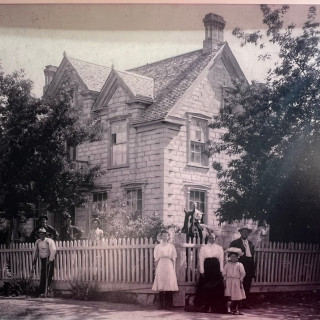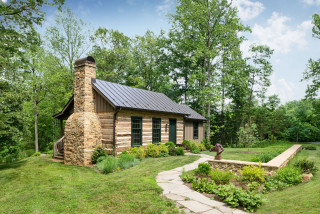
This article was originally published by a www.houzz.com . Read the Original article here. .

This article was originally published by a www.houzz.com . Read the Original article here. .

Cabin at a Glance
Who lives here: A couple
Location: Middleburg, Virginia
Size: 500 square feet (46 square meters)
Architect: Tim Clites of Clites Architects
Contractor: Richard Williams of Deerchase
The cabin sits in a clearing atop a hill, with views of the Bull Run Mountains. “[It’s] an easy walk from the main house, but it’s just far enough to feel like they are getting away,” Clites says.
The couple hired Clites, who had designed the main house, and contractor Richard Williams to make the cabin work for the activities they envisioned. New elements include openings for windows and doors, a chimney, a small addition (seen on the right with wood board-and-batten siding and a pigmented stain) and a back porch.
The late-18th- or early-19th-century cabin originally sat about 70 miles from where it is now. “[It] basically arrived as a bundle of logs,” Clites says. Williams had a bit of a giant Lincoln Logs puzzle on his hands. He and his team laid out the sills and joists on the ground first to see what they had and to get a measurement for the foundation.
Maintaining an authentic historical feel was the goal, but keeping the cabin frozen in time was not. Williams is passionate about old buildings. He paid meticulous attention to detail and sourced reclaimed materials. He also relied on a deep list of contacts, including expert craftspeople, to help give the log cabin authenticity.
One such craftsperson who worked on the project was Lewis Whitesell, an expert mason. He designed and constructed this chimney from fieldstones in a style that would have been used when the cabin was built. Even the firebox is fieldstone rather than firebrick. The half-barrel-shaped cap is a more modern detail that protects the chimney.
Find a local architect on Houzz
This article was originally published by a www.houzz.com . Read the Original article here. .
“Kitchens in 1883 would not have had built-in cabinetry as we know it today,” McCarley says. “Instead, they relied on freestanding tables, plate racks and wall-hung shelving. We echoed this tradition through using open shelving, custom plate racks and a stunning mahogany island.”
The homeowner found the local craftsman, Dale Peel, who built the island and all of the cabinets. They kept as much of the original trim and moldings as they could, and Peel matched them as needed.
The home’s narrow doors posed a challenge once again when the island was delivered, however. “They couldn’t get the island in the house, either,” McCarley says. “We had to take it back home and take all the legs off, bring in the top, bring the legs in separate and put it together!”
Paint: Pale Oak (cabinets) and Wythe Blue (trim), Benjamin Moore